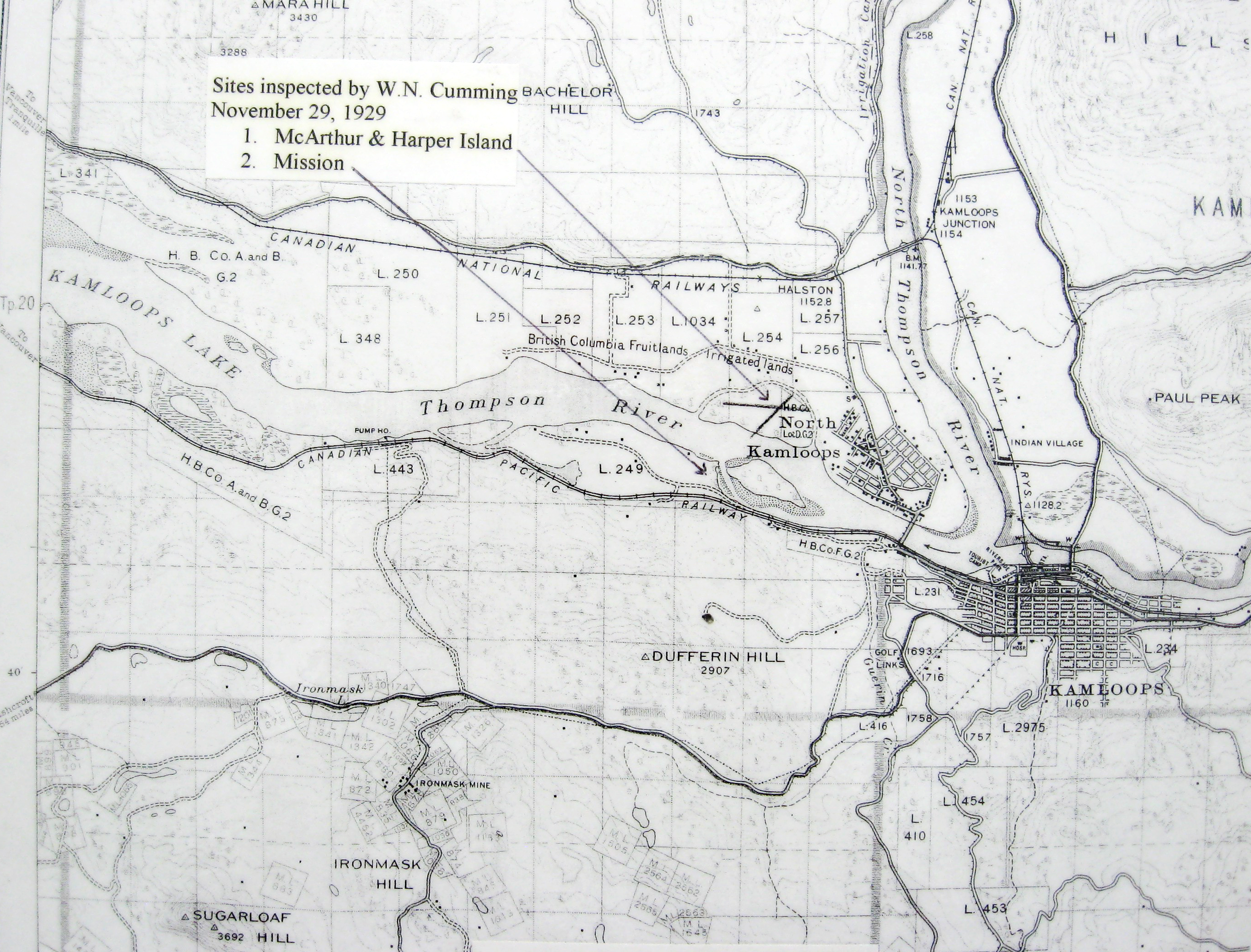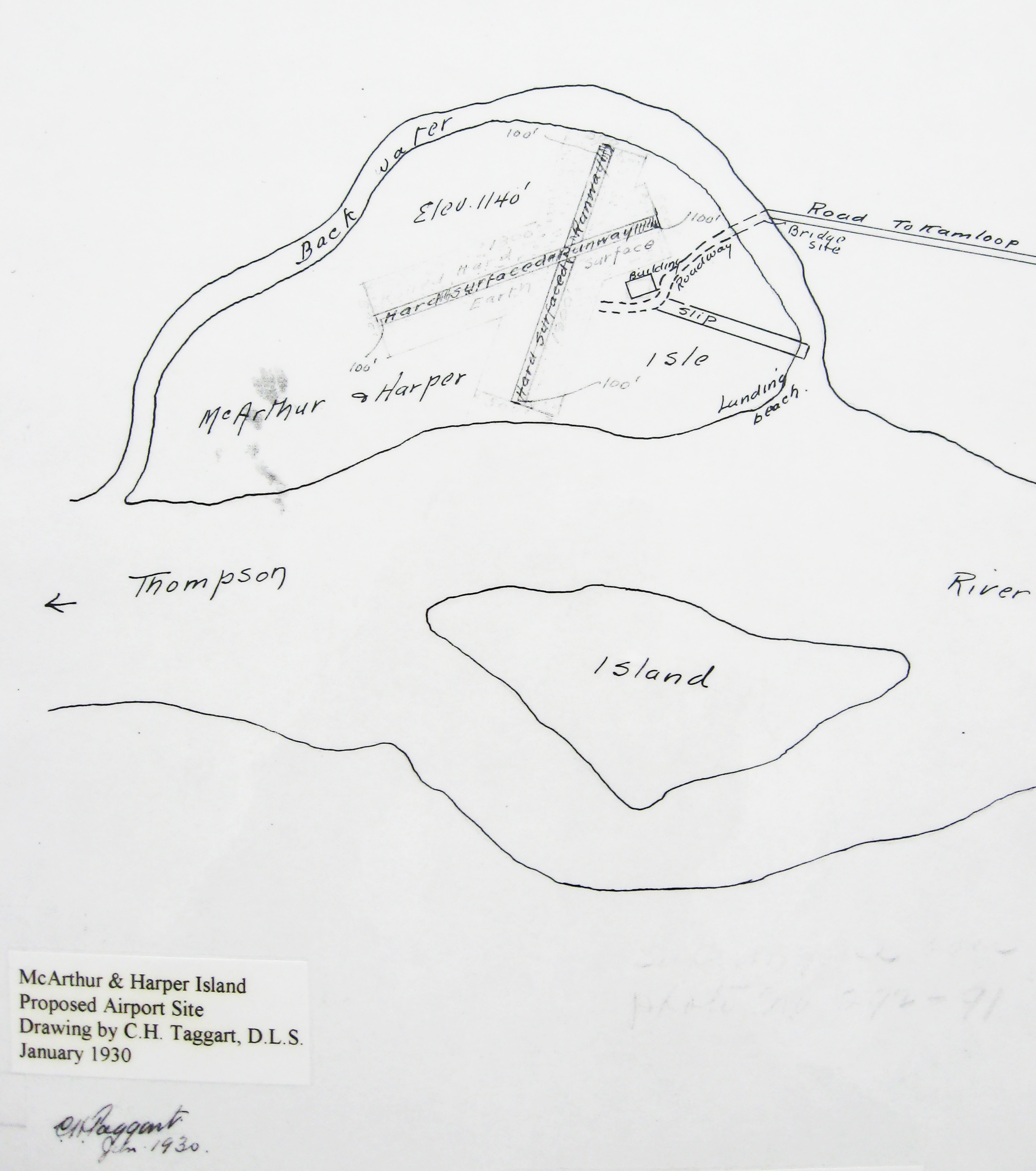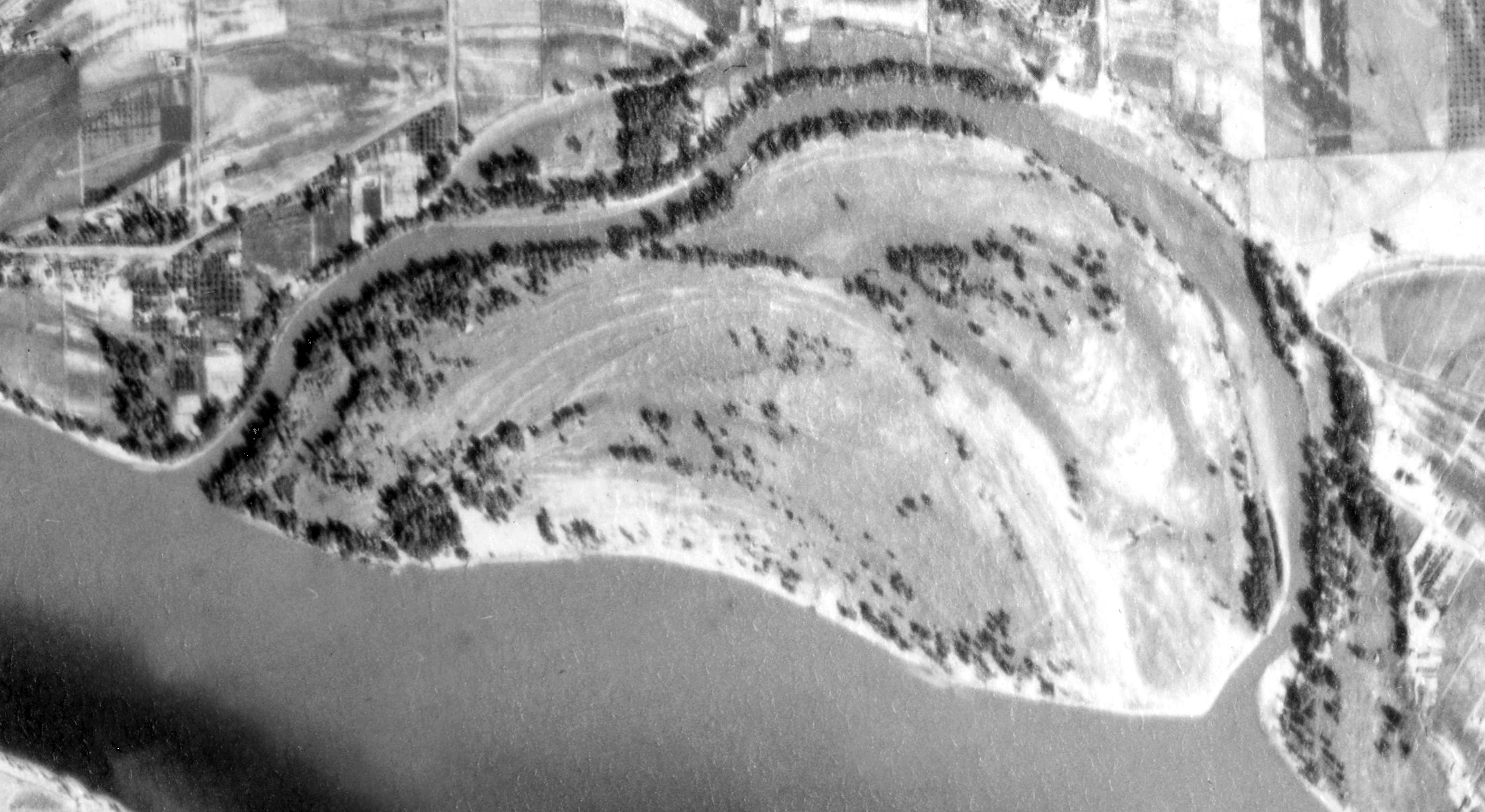McArthur Island
McArthur Island Park has evolved from a sandy island through several uses to become one of the most valued multi-use parks in the Kamloops area.
*Background Image courtesy of City of Kamloops, Aerial Archives
Geophysical Evolution
McArthur ISland formed over a period of about 10,000 years as the flood waters of the Post Ice Age Thompson lake receded.
The value of this specific land to the Tk’emlúps te Secwépemc people is not known.[1] Its position on the north shore of the Thompson River with year round access to fish and river based animals for food and furs suggests it would undoubtedly have been part of the seasonal food sources of the Secwépemc people.
In 1855, Alexander S. McArthur, owner of a butcher shop on Victoria Street, took on J. M Harper to be partners in a butcher/grocery store on Victoria Street. They soon gave up the butcher section. Their success required moving to larger premises several times and opening a branch in another town.[2] Mr. McArthur married the daughter of the city’s first mayor, Mr. Sibree Clarke. The store was sold in 1905 and the owners retired. Mr. Harper stayed in Kamloops and became an Alderman. The McArthur family moved to Vancouver and spent summers in Salmon Arm. They moved back to Kamloops in 1913 and Mr. McArthur and his previous partner, Mr. Harper, jointly bought waterfront land on the north shore that included a 140 acre (57ha) island. A 1910 government survey shows the island as Lot 160 of Fruitlands (KMA Map 197). The island became known as McArthur & Harper Island.
The McGowan Dairy pastured their cattle on the island in the early 1900’s. It is not known if this continued after the purchase. The new owners did not develop the land, although Mr. McArthur referred to it as his “island park.”
*Background Image courtesy of City of Kamloops – 1928
McArthur & Harper Island
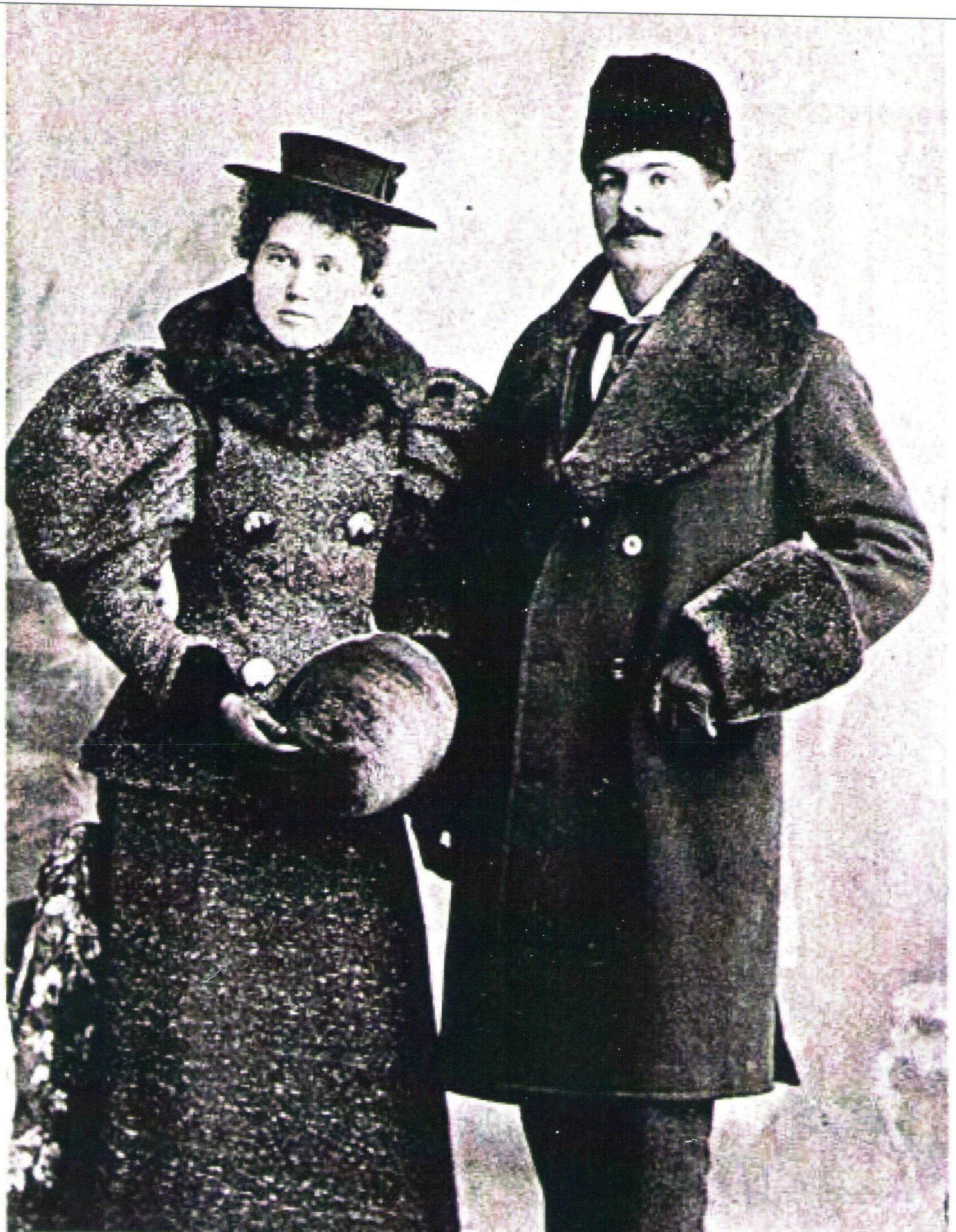
McArthur & Harper Island as a possible Airport Site.
McArthur & Harper Island was one of several sites once considered for an airport. Two pilots, W.M. Cumming and C.H. Taggart, were sent by the Vancouver Airport Authority to each examine possible sites and advise the City Council regarding the best airport site. Both used hand drawn maps when they presented the potential of McArthur Island as an airport to the City Council: W.N. Cumming on Nov, 1929 and C.H. McTaggart, on Jan, 1930. The City of Kamloops already had an option on the 147 acre McArthur & Harper Island that had been surveyed, and had created a bylaw giving notice of its plan to make the Island an airport. The newspaper report on the pilot’s visits included, “This island has been favourably considered by flying men as a suitable airport site and could be connected to the mainland by a bridge“(Kamloops Sentinel, Nov 29, 1929, p.1)
McArthur Island was also included in Mr. Edgar C. Thrupp’s, January, 1930, presentation to City Council. He incorporated property he owned and that of some neighbours, as being most appropriate for an airport. He pointed out the annual flooding and wind problems on McArthur & Harper Island and the cost of a bridge required for access. He too presented a map with proposed runways including one on McArthur & Harper Island (Kamloops Sentinel, January 31, 1930, p. 1).
When Harper sold his portion to McArthur, the island’s name became McArthur Island.
An Early Natural Playground
Children from the neighbourhood played on the island in the 1940’s when the island was mainly sandy with few trees and shrubs, similar to Rabbit Island. They swam and built rafts to get to McArthur Island in summer and played hockey in winter on the frozen slough (KTW, Nov. 30, 2018, p.14). The island flooded in 1948 during high water that year.
Village of North Kamloops includes McArthur Island
Following a successful referendum in 1956, The Village of North Kamloops bought the 150 acre (60.7 ha) McArthur Island for $25,000 in 1957.[3] Within a year, 4ha had been planted in turf. During the next two years, a sewage lift station, 5 acre sewage disposal lagoon, a dog pound and electrical power were installed. A flood lit baseball diamond was planned.
McArthur Island, while now village owned, was outside the boundaries of North Kamloops. In September, 1959, a successful plebiscite changed the status of North Kamloops from village to town.[4] The referendum also approved including the island as part of North Kamloops in order to have bylaws cover issues such as “zoning, building, dog control etc.” (Kamloops Advertising Sentinel, June 26, 1959, p.3).
North Kamloops’ Vision for McArthur Island as a Recreational Playground
McArthur Island becomes the Centennial Project. In 1959, the North Kamloops Centennial Committee chose McArthur Island as the North Kamloops project for Canada’s Centennial in 1967. Plans were approved for a provincial centennial sports field including baseball, softball and football.
Before this could be done, the island required increased elevation to avoid the annual flooding. It became the site of a garbage dump as well as sewage disposal. Andy Philpot[5] recalls as a high-school student, “having to run around the island for physical education and we had blowing garbage around us and the smell was terrible!!”
In June, 1960, during informal discussions with town officials, McArthur Island was described as a “future recreational playground” by Albert McGowan, a North Kamloops Commissioner.[6] The central location was considered ideal and the space could include a swimming pool and mooring for yachts (Kamloops Sentinel, June 2, 1960, p.3). By this time, the island had 10-acres (4ha) of centennial playing fields, a dog pound, a sewer lift station, a sewage lagoon and a game reserve. The only access to the island was via a road bridge over the slough at MacKenzie Avenue that contained the sewer lines bringing neighbourhood sewage to the island lagoons.
|
Picnic and playground areas were to be developed by the North Kamloops Lions Club as well as a five-acre space for the Kamloops Light Horse Club. As per the city’s plan to have proposed city swimming pools located close to schools, the proposed swimming pool would be “between the Centennial playing fields and the North Kamloops Junior-Senior High School on the mainland,” (Kamloops Sentinel, June 2, 1960, p.3). It was thought yachting facilities could be developed by a club, and the swimming pool would be a North Kamloops project. |
A 12 acre sewage lagoon was added in 1960, to “handle sewer connections to the village” from the expanding residential areas to the island disposal lagoons (Kamloops Sentinel, June 2, 1960, p.3). The connections were embedded in a new road bridge at 12thAvenue, providing a second access to the park.


A large sports center was constructed in 1964. It included an ice rink and 6 curling rinks with bleachers, washrooms, locker rooms, lounge and bar (Kamloops News Advertiser, Feb 10, 1971, p1.). The North Kamloops Curling Club opened in 1965, holding Bonspiels and growing the membership. By the late 1980’s, a club manager was needed to manage the bar and Bonspiels. In 1987, a seniors’ league was formed. In 2001, the club changed its name to the McArthur Island Curing Club. It hosts 3-5 Bonspiels per season (September-March).
In May, 1967, The North Kamloops Public Works Department built a 7 ft. (2.13M) dike around the island with the exception of the boat launch to, “combat a possible flood threat and prevent damage to the large sports centre and arena, and also the site of the Centennial stadium” (North Kamloops News Advertiser, May 31, p.1). The top of the dike was paved to create a road, thus preventing cars driving on the lawn. The boat launch area was designed to be quickly filled in should flooding be predicted.
Norbrock Stadium was also built in 1967, as a Canadian Centennial Project. It is a regulation size baseball field with bleachers for approximately 1500 spectators. The Kamloops International Tournament hosts both Canadian and American teams each July.
The amalgamation of the Town North Kamloops with the City of Kamloops resulted in the island park becoming a responsibility of the City of Kamloops.
In 1968, City Alderman Gordon Bregoliss, described the Island as “too valuable to keep holding for sewer lagoons,” (Kamloops News Advertiser, July 24, 1968, p.9). The City Council approved spending $1.8 million to remove the sewage lagoons creating 45 acres of land for park development.
In February, 1971, the City of Kamloops revealed a major, long term plan for McArthur Park prepared by a Vancouver firm, Landscape Architects and Park Planners. Details were made public in the front and second pages of the local newspapers (Kamloops News Advertiser, February 10, 1971, p.1-2 & & Kamloops Daily Sentinel, February 10, 1971, p.1). The plan “to take place over many years,” was based on previous plans including a regional recreational study

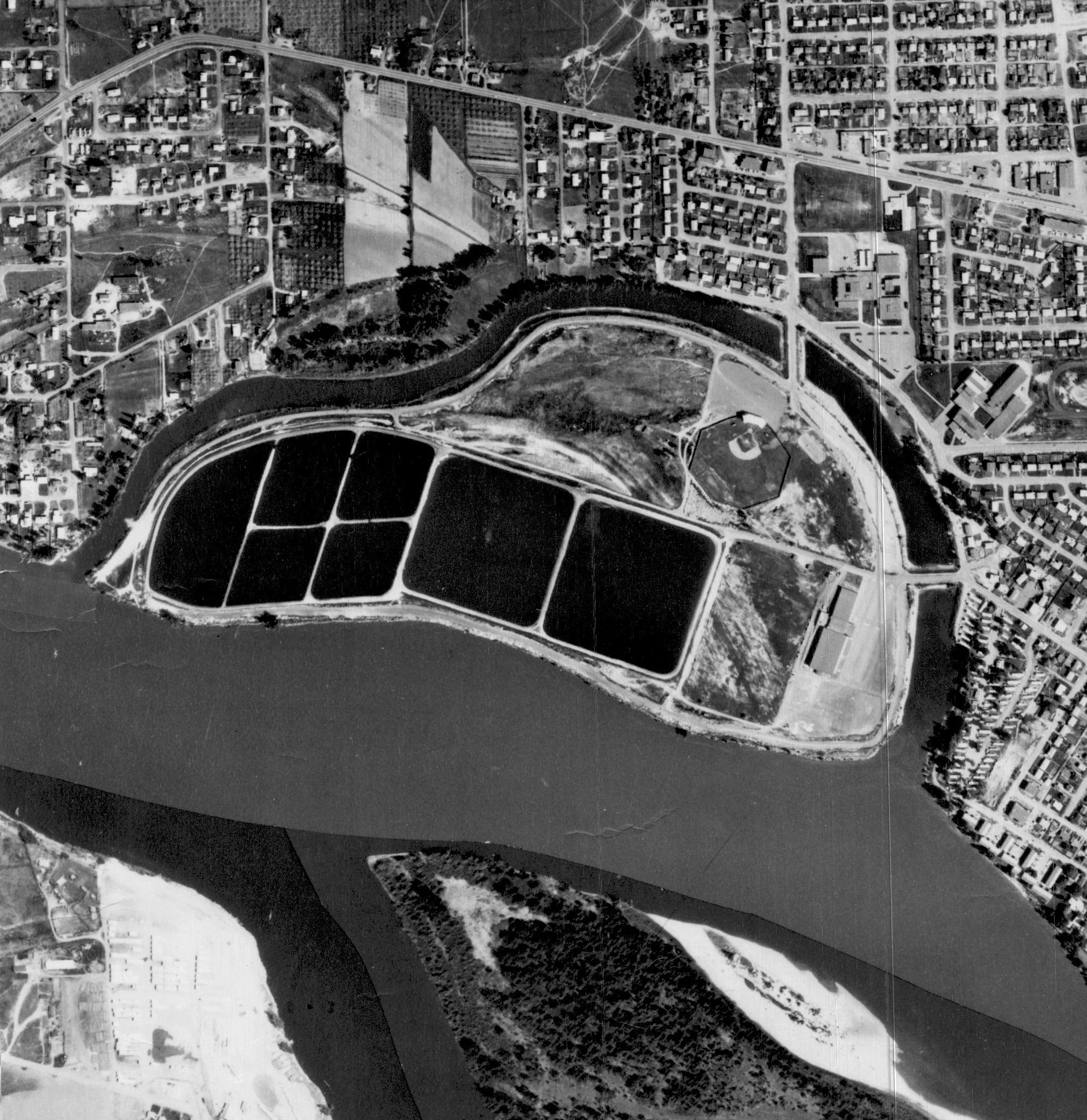
Proposed facilities, to be set in a landscaped setting, were divided into five major zones: 1) the stadium, tennis courts, 25 meter pool complex, 2) the ice arena and marina complex, 3) the playing fields, 4) the golf course along the north side of the park, and 5) a passive and picnic area on the west end of the island that could be used for square dancing and music festivals. The two entrances would be connected to a loop road for cars, bicycles and pedestrians with peripheral parking that would provide access to facilities around the park (Kamloops Daily Sentinel, February 10, 1971, p.1).
This 1971 plan was considered to be a detailed, “master framework” for a staged development of the park with “various clubs and organizations” to be consulted for ideas. A seniors’ area would include a bowling green, outdoor checkers, chess, shuffleboards and sitting areas. A Kiddyland with a western theme and miniature railroad might be part of the picnic area.
After surveys and opinion polls, construction of a new youth centre was started on the west end of McArthur Island in 1974. The new home of the Boys Club of Kamloops was officially opened on February 2, 1975. On November 17, 1975, the name of the Club was changed to the Boys and Girls Club of Kamloops. Their membership and services increased in their new setting.[8]
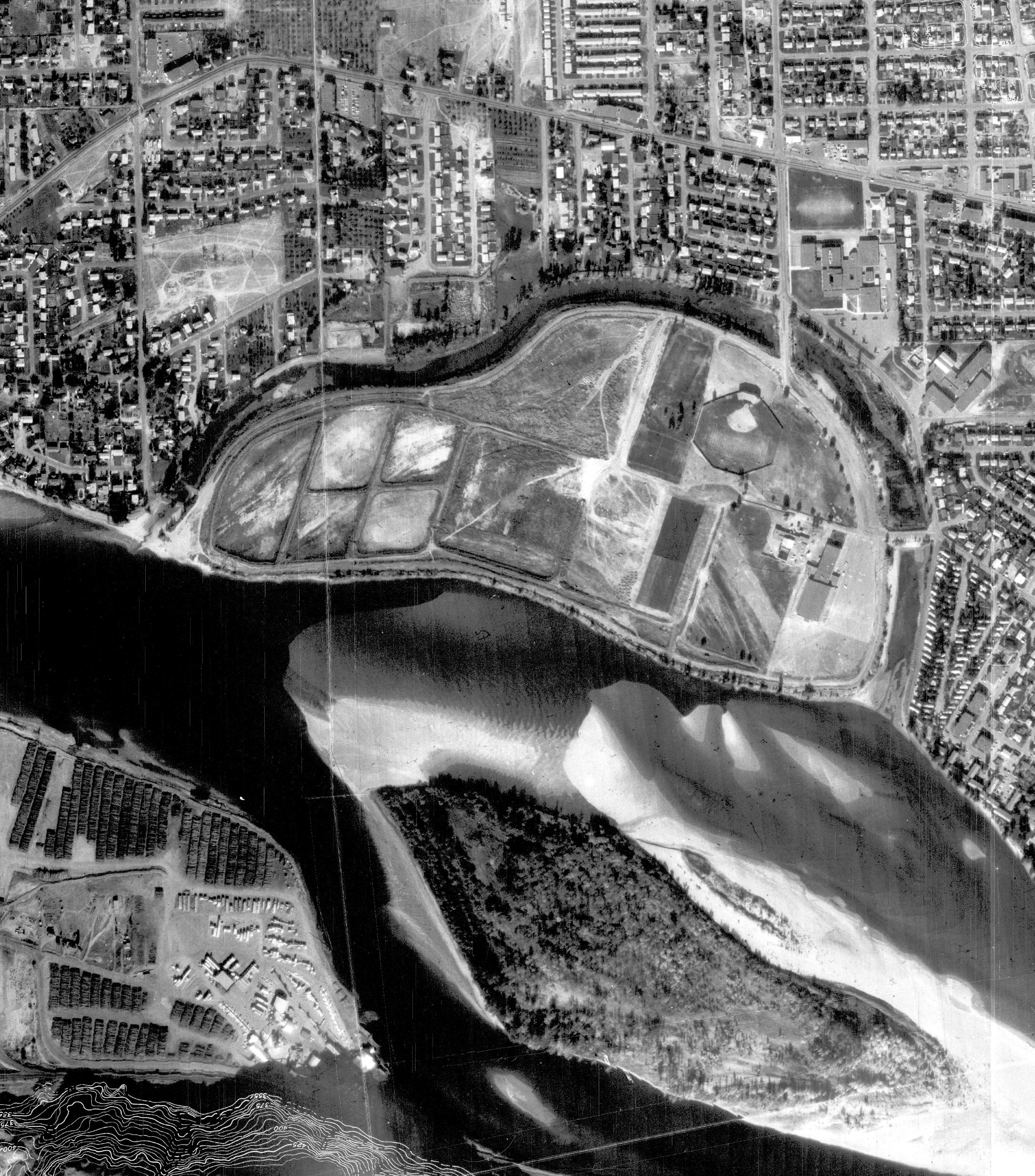
Consultations and Design 1976: In 1976, a 16 year old Grade 11 student at NorKam Secondary School was inspired after hearing Ald. Don Couch speaking about the need for more recreational facilities for the City. While jogging in McArthur Island during a physical education class, Bob Coughlin noticed the lack of trails. He incorporated his ideas into a plan that was presented to the Housing Committee in January 1976, on invitation of the Chairman, Lyle Anderson, who said, “I was particularly interested in these plans because they represent a completely fresh point of view” (Kamloops News, Jan. 26, 1976, p.16).
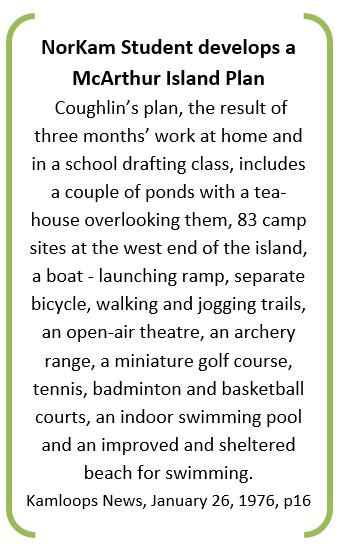
Later in 1976, a comprehensive plan, prepared by the Vancouver firm, Amalgamated Recreation Engineers and Network Associates Ltd (ARENA), was being discussed by the Kamloops Track and Field Association, The Kamloops Senior Soccer Association and the School District 24, with the Parks and Recreation Director of the City (Kamloops Daily Sentinel, November 5, 1978, p1). A stadium would provide seating for a minimum of 3000-5000 people and accommodate 20,000 people in a multi-purpose complex.
The plan included major track and field facilities with a field that could accommodate soccer, football, field hockey and rugby. Tentative discussion included the possibility of gymnastics facilities and a clubhouse to be built under the stadium in the future.
It was thought that a referendum would not be needed, as both grants and newspaper recycling @$24/ton could provide the funds.[9]
A few weeks later, the results of further study by ARENA was again front page news (Kamloops Daily Sentinel, November 24, 1976, p.1). An estimated cost of $800,000-$1.8 M had been determined. The main facility would be a 400 metre, 8-lane track with markings for all hurdle and running events. Inside the oval track would be facilities for long jump, triple jump, pole vault, high jump, javelin, shot put and hammer & discus throw. ARENA recommended the track and field area be constructed first and the stadium would follow. All would be surrounded by the dike that creates a natural bowl.
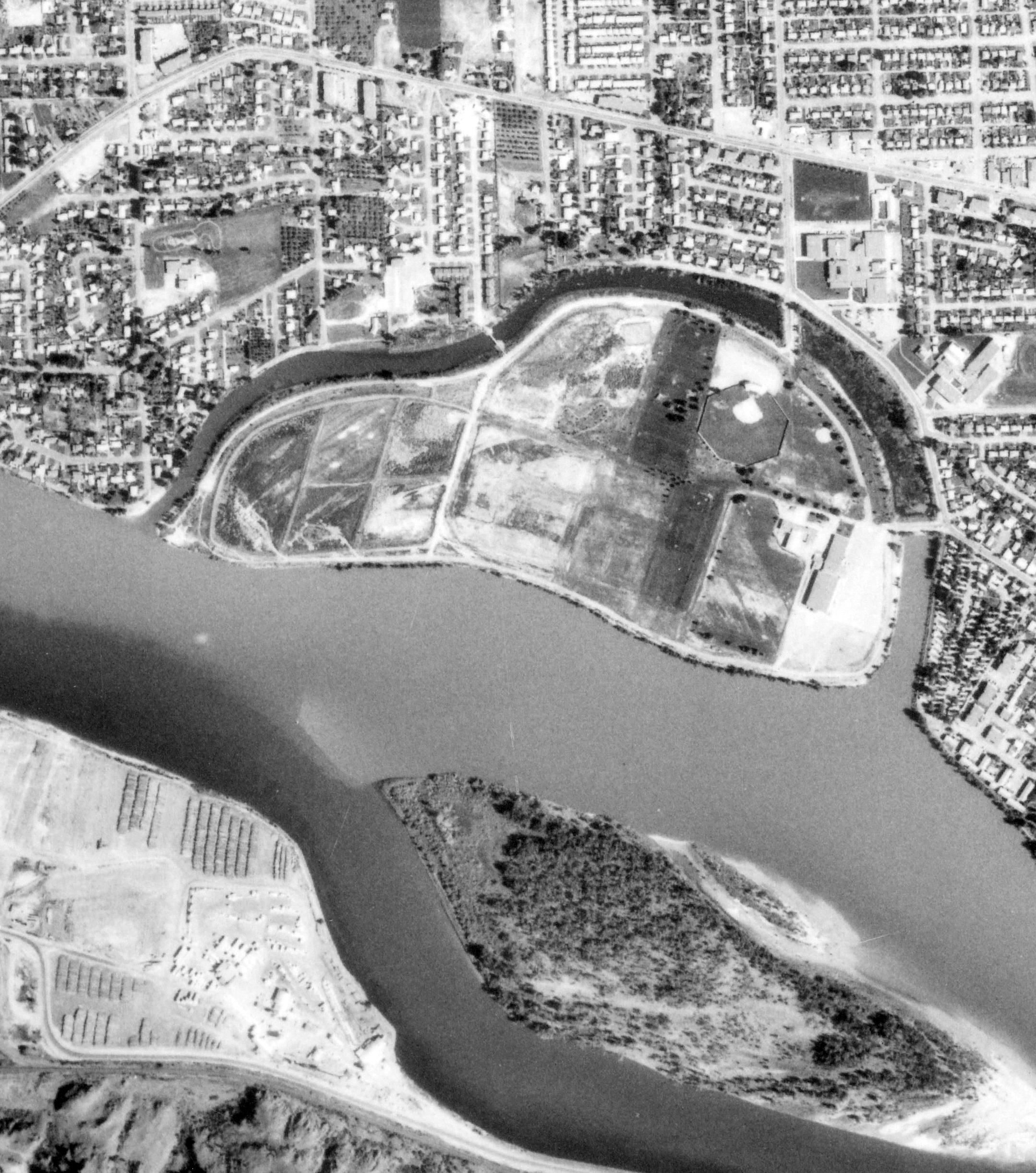
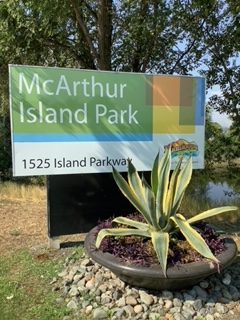
Ald. Bergoliss predicted it would probably need a referendum. The detailed report concluded, “McArthur Island as ideal for the stadium. It rejects the other considered site at the former landfill on McGill Rd as being too expensive to develop,”
A successful referendum in 1978 provided $1.4 million to develop the park.
Development of McArthur Island into a Multiuse Park
The framework has been used to develop the island into one of the city’s most used parks. It has facilities for all ages, interests and abilities.
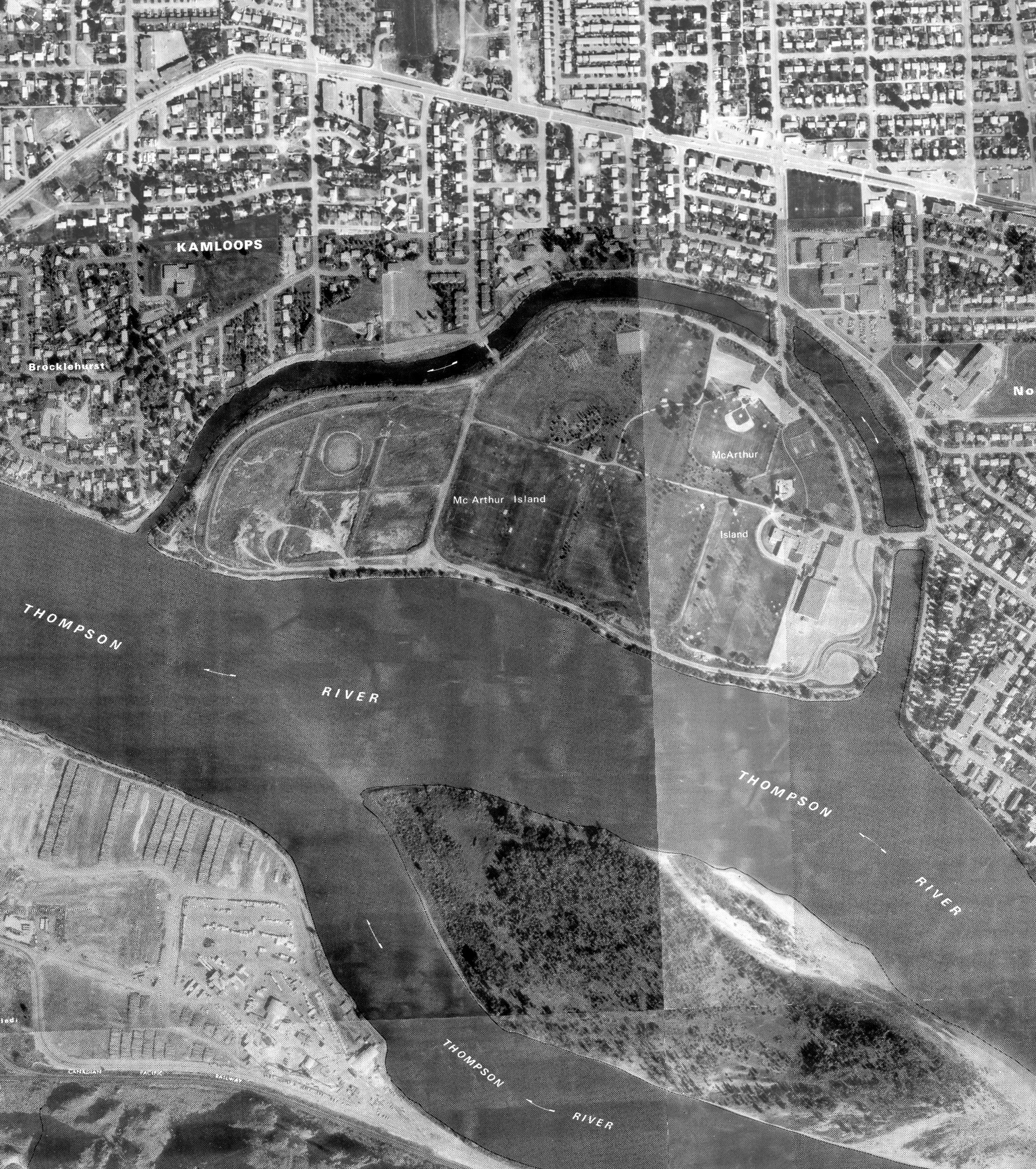
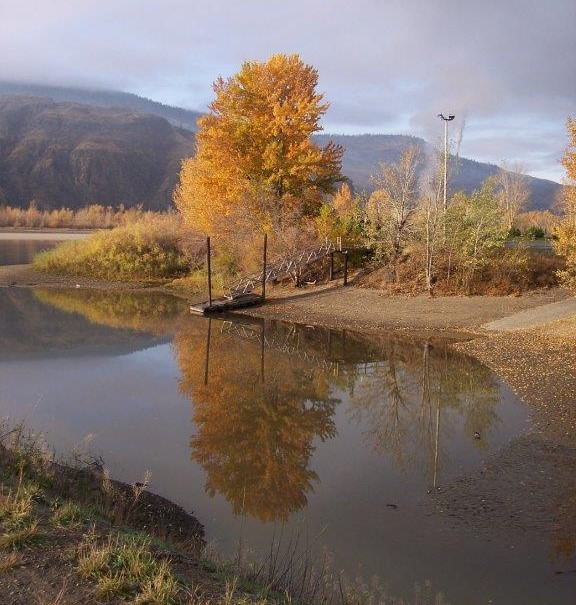
Over the years, sports facilities have both expanded and changed based on the original plan and the changing needs of the citizens. Some of the changes were embedded in controversy for a time. The island has developed into a major sports facility with walking trails that loop around the parks’ sports fields.
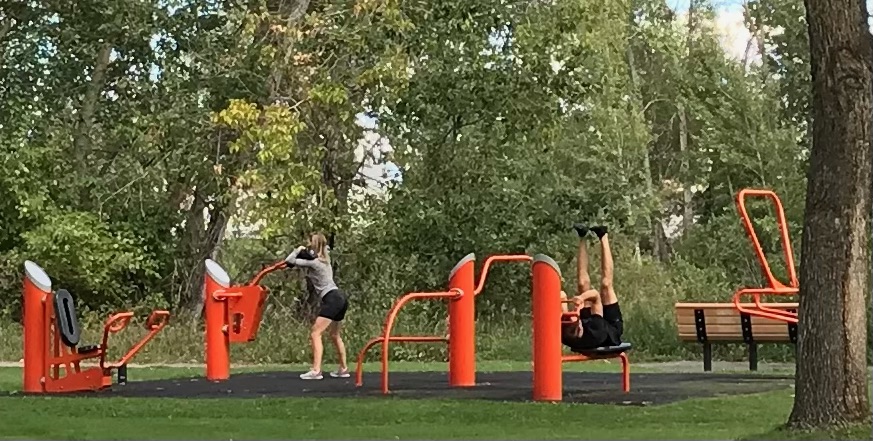
The swimming pool was never built. A BMX course was at the south west end of the park[10] from 1980 until when it was relocated to Ord Road in 2013.
The planned yacht basin is a boat launch on the west side that occasionally sees a yacht. There is a launch pad and steps to a deck for going on or off board.
Lawn Bowling opened in 1985 continues to have an active membership.
Two Outdoor Exercise stations, built initially for seniors, provide a variety of equipment for improving balance and strength for all ages.
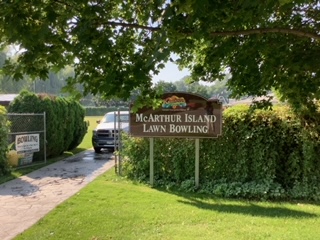
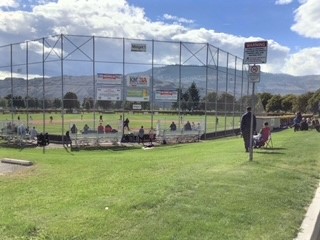
Golf: In 1993, a Kamloops developer, Bill Bilton, leased 6.04ha (16 Acres) and developed a natural grass nine-hole, par-3 course into a comprehensive facility with a covered 40 stall driving range and a 18-hole Mini Golf Course. A club house was built that housed a pro shop and a popular restaurant named The Press Box. The club employed two professional golfers qualified to provide golf lessons to all ages and skills. For many years, it was known as a comprehensive Golf Club, introducing golf to newcomers, challenging those of various skills and hosting major tournaments.
Outdoor Field Sports: The Canada Games Ball Field is a legacy from 1993 when Kamloops hosted this national event in McArthur Island Park. The park currently has many playing fields for mainly baseball (12 diamonds) soccer (9 full-size and 1 mini field).
In 2003, public consolation was sought for another major expansion of both indoor and outdoor facilities, services and expanded at McArthur Island. The Tennis courts that had existed for many years on the north side of the park were removed and playing field numbers and services were expanded.
Indoor Ice Sports: Following the 2003 consultation, additions were made to the Sports and Events Centre in 2005. The curling rinks were separated from the ice rinks by adding an Olympic size hockey rink. The new rink was used by the Chinese team in preparation for the Vancouver 2010 Olympic Winter Games. The Sports Centre houses 6 curling rinks, and an Olympic size skating rink for both junior hockey and figure skating. It has a large lobby, meeting rooms and space for major floor exhibitions and event
The previous golf club building the Kamloops Sports Council, Kamloops Blaze Soccer Club now houses several groups including Kamloops Adults Leaners Society.
Introducing New Sports: As new sports became popular, such as skateboarding, roller blade-ing and disc golf, facilities were developed. Widening of the roadway and sidewalks made rollerblading, biking and all users safer.
The Rotary Skate Board Park was completed in 2004 and is always busy with boarders of all ages and abilities. A small playground and picnic area provides space and activities for other family members.
Disc Golf Course: Extensive flooding in the spring of 2018 required closure of the golf course for extensive reconstruction. This, plus declining enrollment led Bill Bilton, who, by this time, had developed and operated the McArthur Island Golf Course for 25 years, to decide not to continue his lease. The city proposed removing the golf course and designing a course for the new and popular disc golf. “I fully support the city’s vision to bring new recreational opportunities to the island,” Bilton said in a press release (kamloopsthisweek.com, Oct 17, 2018).
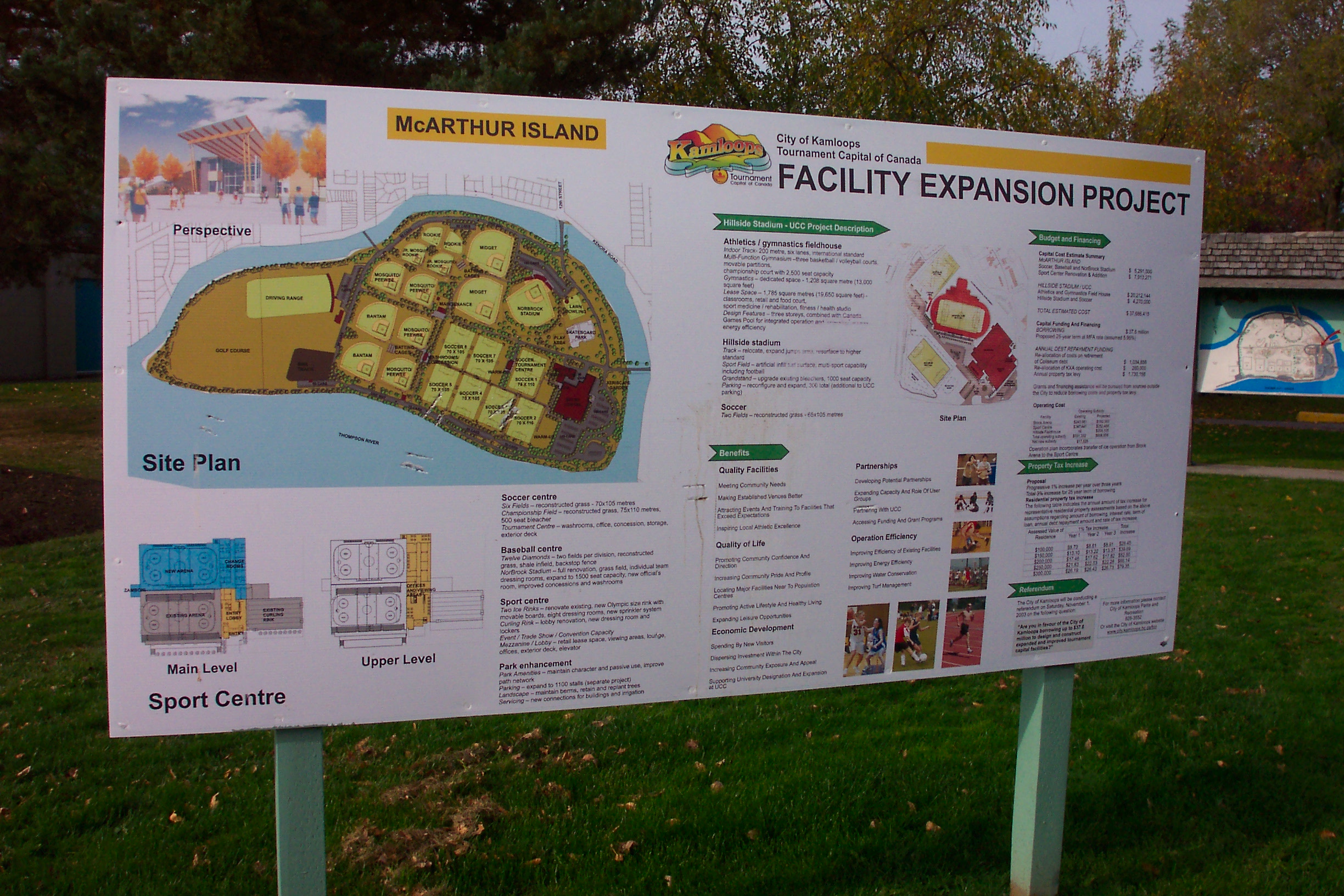
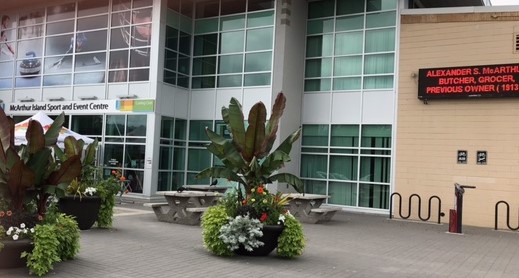
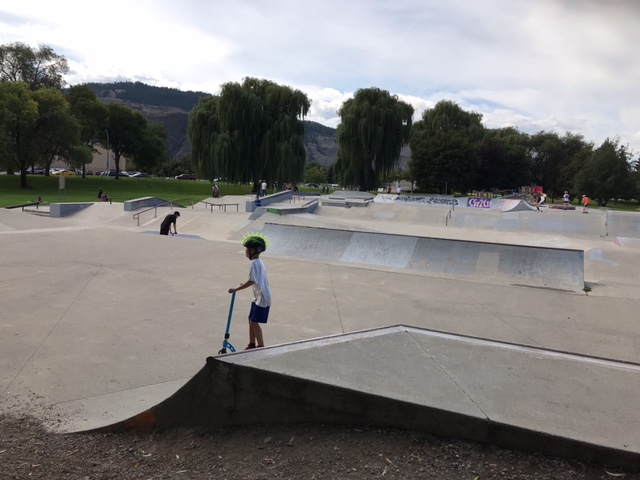
Public consultation revealed conflicting views between the Rotary Club, The Naturalist Club and the Disc Golf Club. The latter were proposing a disc golf course that they felt could be compatible with the Naturalist Club’s wish for passive, supportive natural space, with educational information, including a bee friendly environment. The Naturalist Club was not convinced.
At the City Council meeting in October 2018, an intense discussion took place with representatives of the public and various views held by the Councillors. The area was described by Jeff Putnam[11] as “an absolutely gorgeous property, lots of mature tress, with lots of options for passive and active use.”
In January, 2019, the City Council voted 5-3 to incorporate both concepts on land that formerly housed the McArthur Island Golf Course (kamloopsthisweek.com, January 29, 2019). An 18-hole Disc Golf Course that weaves through a canopy of trees and an extended passive natural area opened in the summer of 2019. The 19-hole mini golf course was revitalized (KTW, June 10, 2018, online edition).
Natural Spaces Development
A natural walk area existed prior to the extension with the disc golf addition. As well, there are beautiful floral and other planted spaces throughout the park.
The Gregson Butterfly Garden was established on the north side of the park as a memorial to Jack Gregson following his death in 2013. A well-known and highly respected city resident, he was an internationally renowned entomologist for his research on ticks, as well as a knowledgeable environmentalist and naturalist, He and his wife, Barbara, were avid and expert gardeners.
Memorial Benches are spaced throughout the park and provide not only a remembrance, but varied frequent resting, conversational, reading and reflection places.
A Nature Walk at the west end of the park takes walkers, runners, bikers, those with walkers or pushing wheelchairs or strollers through a very natural path, out of the view of sports facilities and parking. Providing educational signs along this trial of natural plants and wildlife is ongoing.
Wildlife share the park: The park provides observation of water and land wildlife with owls, bald eagles, osprey, bats, marmots, squirrels, chipmunks, and deer. In the spring, a bear or two might be seen. In 2021, a lynx found the large flock of ducks a food source! The Canada Geese show off their offspring each year and fledgling eagles become independent. The yellow bellied marmots put on winter coats. Bears occasionally appear on the nature trail in spring and fall.


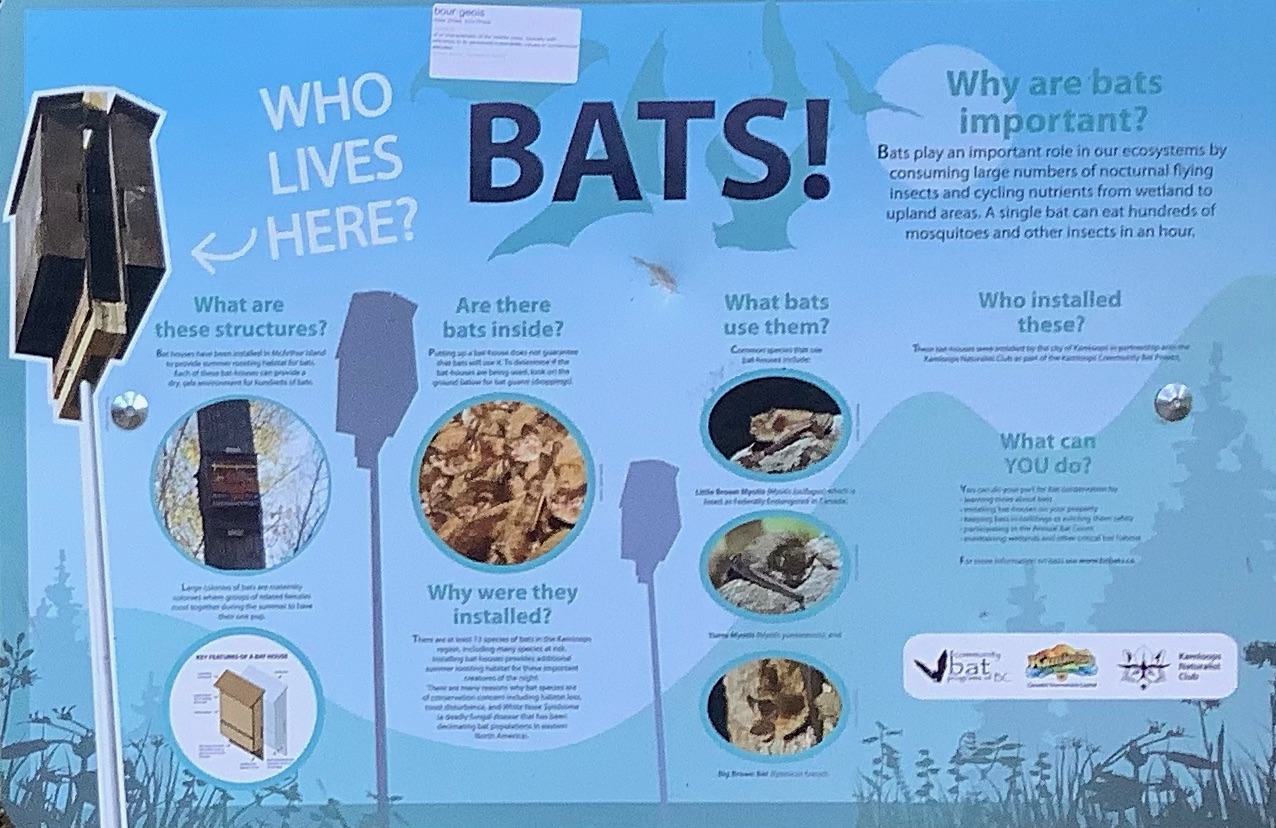

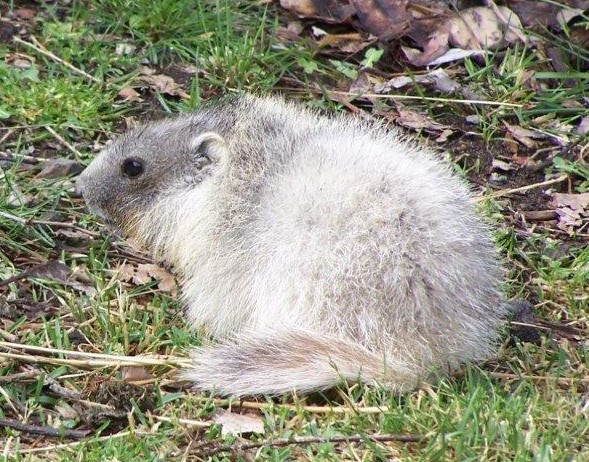
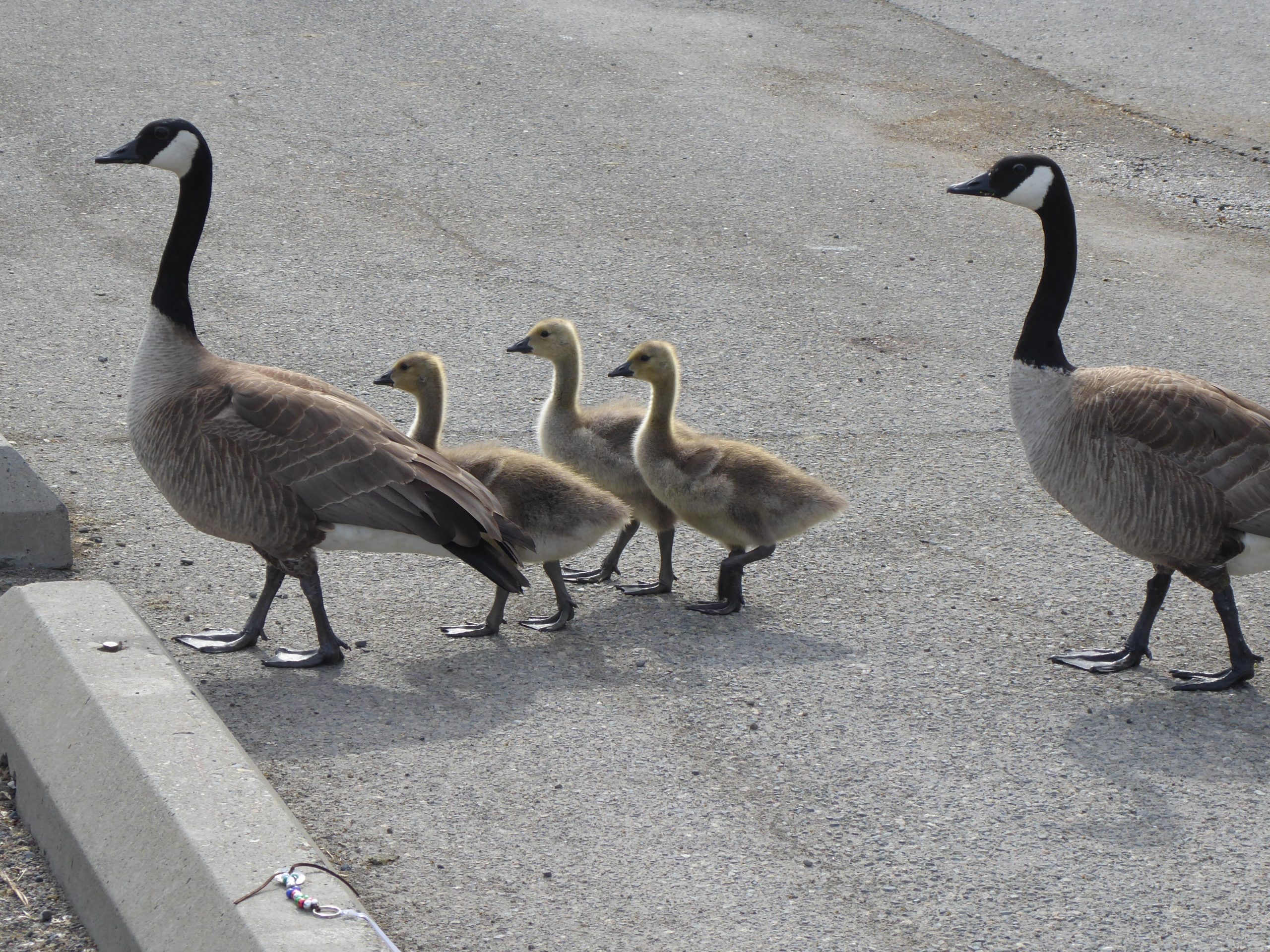

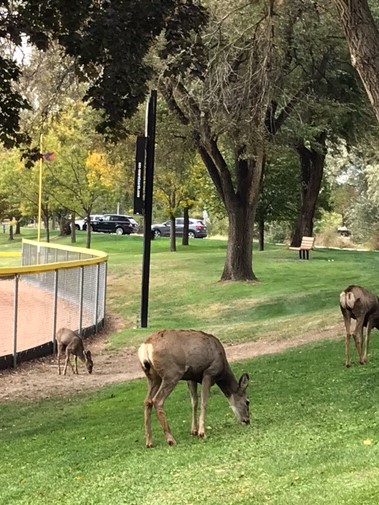

A Xeriscape Garden with covered sitting space is near the MacKenzie entrance. It has covered sitting space,
Creatively designed planted garden areas and pots appear in the park each year. They are varied from year to year and provide colourful interludes with the natural spaces.
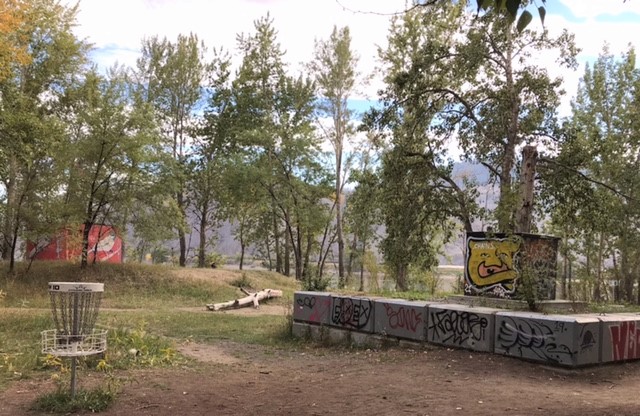
Abandoned Water Source Structures: Also, on the natural trail, two graffiti covered structures are near disc golf baskets #10 and #11. In the spring of 2000, the city drilled and installed a well (round structure) and a rectangular structure for a pump house to increase the city’s water supply. The taxpayers had rejected a $50M water treatment plant.
It was expected that 40 million litres of drinkable water per day could be achieved. The quantity was achieved but water contained high levels of iron and manganese that stained kitchen sinks, tubs and clothes (Kamloops Daily News, February 9, 2010, Online).
This concern was compounded by the public’s opinion that, having been a landfill and sewage disposal site, made this a poor source of drinking water. Having spent $2M, the project was abandoned. Andy recalls, “The round one is a well that the city installed for possible emergency water intake but could not get the water to clean up. There are a number of pipes that go out like the spokes of a wheel out under the river as part of the intake. I can remember the water being pumped out into the river when we went by with the Wanda Sue.”[12] The structures remain in place at the far west end of the park near a beach access, and are covered with graffiti. A water treatment plant was opened on River Street in 2005.
Upgrades and Ongoing Development
In February 2021, a $2M ongoing plan was revealed (Kamloopsthisweek, Feb 12, 2021, online). During 2020, and 2021, major work the one-way ring road around the park included, widening, repairs, paving, and adding some irrigation. More pathways are being added through the natural space.
Covid-19 and access to funding required stopping work on creating a multi-use space on the former golf to include a picnic shelter, a disc golf practice area, another bathroom and a pollinator garden. However, with sports cancelled, access to the fields for maintenance and upgrading of sports was expedited.
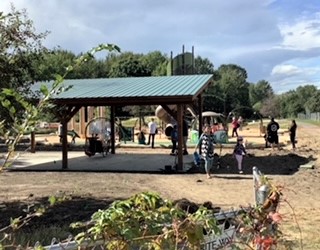
A large custom designed children’s playground, planned for 2022, was opened in October 2021 at the west end of the park. It has many and various activities plus two covered gazebos that provide space for those watching children. It also has inclusive features with access for those in wheelchairs. Perhaps, this is the Kiddyland from the master plan of 1976?
Also in progress is a cultural signage project with the Tk’emlúps te Secwépemc nation
A concrete table tennis is being installed near the exercise equipment in 2022.
McArthur Island is the City’s Most Used Park
The park is the most used park in the city. It includes facilities for all ages and abilities. All trails accommodate many forms of motion during all seasons. When enough snow permits, snowshoeing and cross-country skiing on the trails are possible. Many outdoor tournaments are held on the sports field with seats in bleachers or on raised lawn space that accommodate a large number of spectators.
The park is dog free, compatible with natural spaces and wildlife.
The Sports and Events Centre is the site of trade shows, exhibitions and ice sports competitions. In 2018, and again in 2021, it became an Evacuation Centre for those displaced by wildfires. During spring and summer of 2021, it was a Covid-10 vaccination site.
McArthur Island Park has contributed significantly to Kamloops becoming known as The Tournament Capital Centre.
What would Mr. McArthur think of his “island park?”
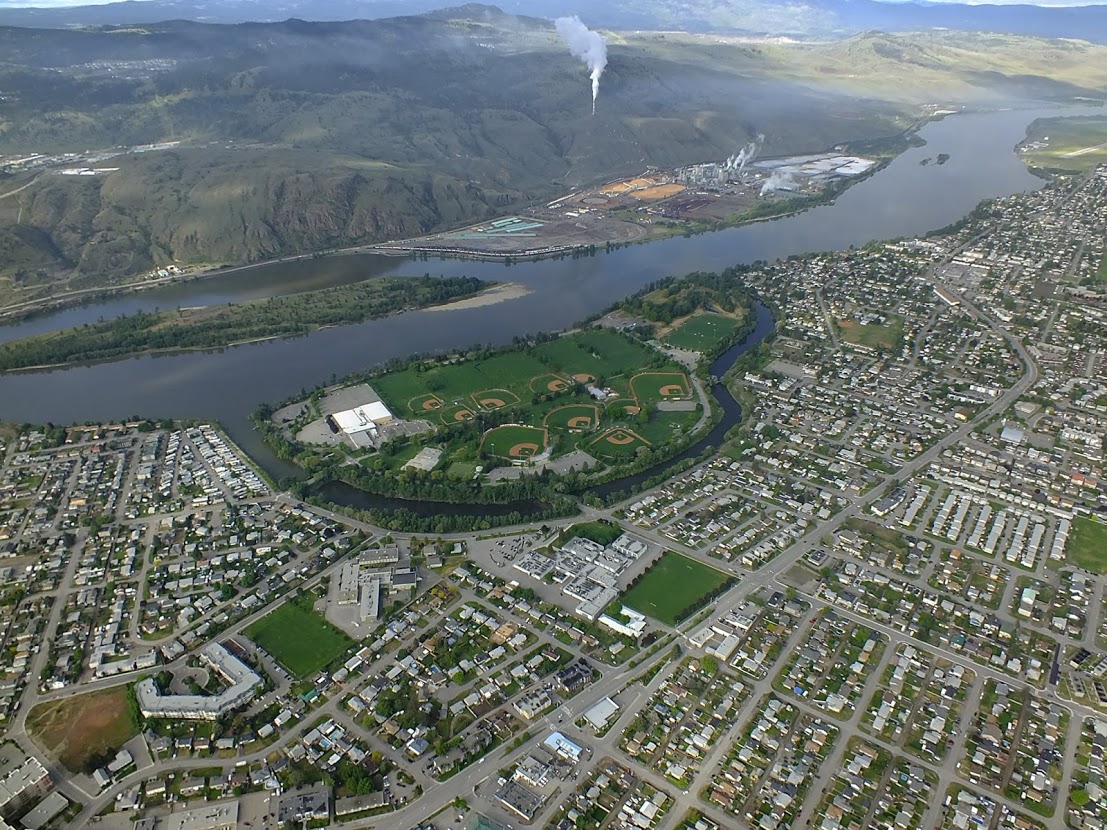

Research and writing by Dr. Colleen M. Stainton with acknowledgement of the Kamloops Museum and Archive resources and in appreciation of editing by Barb Hicks.
FootNotes
[1] The Secwépemc Museum and Heritage Park was not available at time of writing ( Sept. 2021)
[2] One source says Rossland, another Revelstoke.
[3] The original maps cannot be located. As they are more than 50 years old, the copyright is considered expired.
[4] The island was bought from “private ownership,” presumably Mr. McArthur, two years before his death in 1959.
[5] Interestingly, many newspaper reports continued the term “Village” and some, the new term. North Kamloops
[6] Conversation with A. Philpot, St. John’s Ambulance Security Guard at Evacuation Centre, August, 2021.
[7] Public Works Committee Chairman & representative of City Council on the North Kamloops Recreation Committee
[8] The Boys and Girls Club moved to the John Tod Centre in 2014.
[9] The local newspaper was published daily, $.20 per copy. With inserts, the Nov 5, 1978 edition was 62 pages.
[10] Now an equipment and grounds compost area.
[11] Manager of Parks and Civic Facilities
[12] Andy Philpot is the Division Superintendent with St John Ambulance, 627 Victoria Street and was an Assistant Fire Chief with Kamloops Fire Rescue when he retired in 2011. He also worked on the Wanda-Sue Paddlewheeler for 20 years and has been involved with the Kamloops Heritage Railway. He is a well-known volunteer and community supporter.

